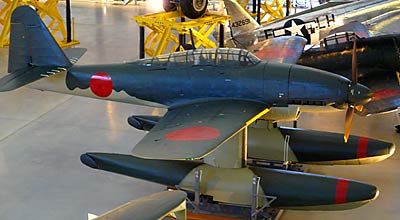 |
 |
 |
 |
 |
| Japanese Submarine I-14 | Japanese Submarine I-14 and I-400 | Japanese Prisoners | Japanese Prisoners | Japanese Prisoners |
I-14 Submarine Specifications
The I-14 is a WWII Japanese Aircraft Carrying Submarine. The I-14's specifications are:
Length: 372' 9"
Width: 38' 6"
Draft: 19'4"
Crew: 114
Displacement: Surface - 2,800 tons / Submerged - 4,010 tons
Max Speed: Surface - 23.5kts / Submerged - 8kts
Range: 24,100 miles
Fuel Capacity: gallons of diesel fuel
Diving Depth: test 330' / emergency ?
Armament:
18 21" torpedoes for 6 bow tubes
2 Triple Type 96 25mm anti aircraft gun mounts
1 13mm Type 93 heavy machine gun
2 Aichi M6A1 Seiran seaplane bombers
Power Plant: Two 2,400hp electric motors powered by diesel electric generators driving 2 screws
Launching Date: March 14, 1945
At the end of the war the Japanese aircraft carrying Submarine I-14 rendezvoused with my Dad's Destroyer Escort, the USS Bangust. The crew disembarked and were searched and an American prize crew was placed on board. My dad had mentioned that the USS Bangust's crew had Thompson submachine guns at the ready while the Japanese prisoners were on board. It wasn't until I scanned the images and enlarged them that I could see in the third photo to the left of the hatch a crewman with a Thompson pointing skyward. Dad also mentioned that the prisoners seemed really happy. Again I didn't see it until I enlarged it, but in the last photo the prisoners are waving their hats and some are clearly smiling.
The I-14 submarine had a hangar for 2 Aichi Seiran seaplanes and a catapult launching ramp up front. Its purpose was a one way trip to the Panama Canal to bomb and disable one of the locks with a single 1,764lb Steel tipped bomb. The hangars of both the I-14 and I-400 were empty when the Japanese crews surrendered their submarines. At the time the crews answered their interrogators that they didn't want the aircraft to fall into enemy hands. It wasn't until the last few years that the real reason the Serians were shoved overboard was revealed. I-400 crewmen interviewed for the book "I-400 Japan's Secret Aircraft-Carrying Strike Submarine" stated that to ensure the planned attack on the Panama Canal was successful, the Serians were painted in US colors and markings. The crews feared they would have been executed upon surrender had that ruse been discovered at the time and heaved the Serians overboard.
A present day photo of a restored Aichi Seirans Float Plane is below:

Aichi M6A1 Seiran Float Plane at the Udvar Hazy Aviation Museum
This example
of the Seiran has been restored and is on display at the Smithsonian Institution
in Washington DC. Read
more about the Seiran on the Smithsonian
Allen who's father served as a combat reporter for the US Marines in the Pacific has a very good photo of both the I-14 an I-400 submarines together alongside the sub tender Proteus. Looking at the sailors on deck you get a feel for how truly massive these Japanese submarines were.
A Japanese Type A Midget submarine can be found at the USS Nautilus Museum in Groton, CT.
News Flash! November 13, 2009
The Japanese aircraft carrying submarine I-14 has been found off the coast of Oahu. You can read more about the discovery in this article on the discovery of the I-14 submarine in the LA Times. It looks like the National Geographic Channel will be doing a segment on the aircraft carrying submarines I-14, I-400, and I-401 in the near future.